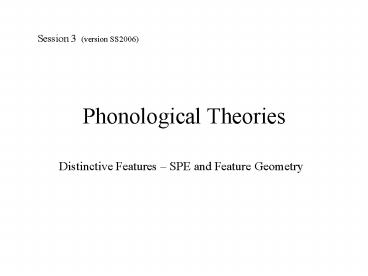Phonological Theories - PowerPoint PPT Presentation
Title:
Phonological Theories
Description:
Chomsky and Halle (1968) derived the phonological structure from the morphological structure. ... Does the feature-geometry scheme by Halle 1992 contain ... – PowerPoint PPT presentation
Number of Views:144
Avg rating:3.0/5.0
Title: Phonological Theories
1
Phonological Theories
Session 3 (version SS2006)
- Distinctive Features SPE and Feature Geometry
2
Post-Jakobsonian Features (SPE)
Syntactic component
- Chomsky and Halle (1968) derived the
phonological structure from the morphological
structure. Phonemes (as units in the observable
surface form) were no longer required.
Base rules lexicon
SemanticallyinterpretedDeep Structures
Deepstructure
Semanticcomponent
Transformationalrules
PhoneticallyinterpretedSurface Structures
Phonologicalcomponent
SurfaceStructures
3
Post-Jakobsonian Features (cont.)
- The features were more dependent on the
articulatory configuration, so more
differentiated features were required (e.g. not
rounded, pharyngealised and retroflex as flat) - All phonological features were strictly
binary.(the distinction between underlying and
surface forms allowed phonetic features to take
on continuous values) - Focus very much on inherent (segmental)
features. Only stress was theoretically developed
to any degree.
4
SPE Inherent Features 1
- Features defined along four dimensions
(compared to the three by JFH) - - Major class features.
- - Cavity features.
- - Manner features.
- - Source features
- Apart from the first dimension, these reflect
the articulatory, production perspective rather
than the acoustic/perceptual.
(functional definition)
(articulatory definition)
5
Comparison of Inherent Features 1
6
Comparison of Inherent Features 2
7
Unordered vs. ordered features
The features (as presented so far) are
subclassified according to function - major
class features - or production properties -
cavity, manner and source features. But
there are no dependencies between the features.
Nick Clements (1985) presented a grouping of
features which took the link between features
and their articulators into account
This ordered view of features is known as
Feature Geometry
Some features are regarded as independent of a
particular articulator (e.g. consonantal,
sonorant, approximant)
Other features are dependent on a specific
area of the production system (e.g. voiced,
vs. nasal)
Other features are clearly dependent on a
specific articulator (e.g. round, high, ATR)
8
Basic Geometry for Features(after Clements 1985,
cf. Spencer 155 ff.)
9
Feature Geometry (all)
10
Example Feature Geometry representation of /t/
??
11
Example Feature Geometry representation of /t/
??
12
Example Feature Geometry representation of /t/
??
13
Example Feature Geometry representation of /t/
??
14
Example Feature Geometry representation of /t/
15
Alternative Feature Geometry scheme (Halle 1992)
16
Feature Geometry (all)
17
Exercise (written)
- Specify a SPE and a JFH matrix for the word
Standlicht and - compare.
- Make notes of any problems, queries or
objections you have!
2. Draw a series of feature-geometry trees for
the same word. (use the Clements arrangement)
- Does the feature-geometry scheme by Halle 1992
contain - any theoretical or practical differences when
compared to Clements/Spencer?































